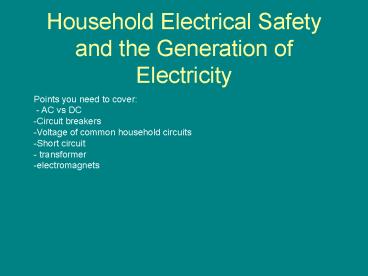Household Electrical Safety and the Generation of Electricity PowerPoint PPT Presentation
1 / 14
Title: Household Electrical Safety and the Generation of Electricity
1
Household Electrical Safety and the Generation of
Electricity
- Points you need to cover
- - AC vs DC
- Circuit breakers
- Voltage of common household circuits
- Short circuit
- transformer
- electromagnets
2
Weve looked at circuits like this
Weve imagined the electrons making laps around
this circuit. - Remember the Magic School Bus
going around and around the circuit with the
light bulb
3
In a battery powered circuit, current flows in
one direction.
This is called Direct Current, or DC
4
But not all current flows in one direction
The light bulb doesnt care which direction the
current is flowing. If there are electrons trying
to squeeze through the filament, it will glow and
the bulb will light.
5
Whether the electrons are flowing this way
Or this way, the bulb will light
If we could push the same group of electrons
back and forth through the light bulb over and
over again, the light would stay lit.
6
Picture it like this
../../../voltlevels/index.html
When the direction of the current alternates, we
call this Alternating Current, or AC
7
Comparison to Waves
8
For your notebook
- Alternating Current
- Electrons move back and forth. Direction changes
many times each second (US 60 times per second,
or 60 Hz) - Voltage goes up and down.
- Your wall outlets use AC
- Can be sent long distance
- Direct current
- Electrons move in one direction
- Voltage is constant
- Batteries produce DC current
- Its difficult to send it long distances.
9
How do you make Alternating Current?
You can pull electrons a little bit back and
forth with a magnet.
10
Why is this useful?
You can make the electrons move back and forth
through the wire by spinning the wire near a
magnet
This is how GENERATORS work
http//www.wvic.com/how-gen-works.htm
11
Transformers - FYN
- Change the voltage up or down
- Step up transformers make voltage higher
- Step down transformers make voltage lower
12
Household Voltages - FYN
- 120V AC 60Hz
- Regular household outlets
- 240 V AC 60 Hz
- Clothes Dryers
- Electric Ovens
- Refrigerators
13
Household Electrical Safety - FYN
- If the current (amount of electrons flowing
through a wire each second) gets too high, it
could cause the wire to overheat and start a
fire. The circuit is overrloaded. - CIRCUIT BREAKERS are switches that will open a
circuit when the current flow gets too high to
prevent fires. They can be reset. - FUSES will break and open a circuit when current
flow gets too high. They must be replaced.
14
Short Circuits - FYN
- If the RESISTANCE in a circuit is very low, the
current can get very high.
V I R
- A lot of current flowing through a wire can make
that wire overheat.
- The resistance can get very low when you connect
one side of a battery to another.
This is called a SHORT Circuit

